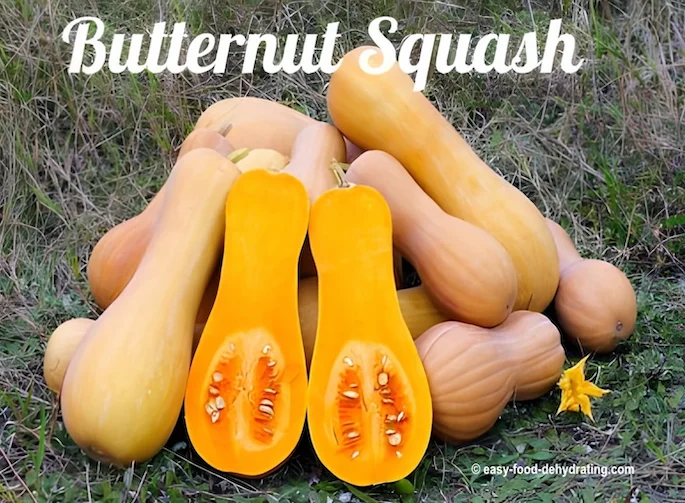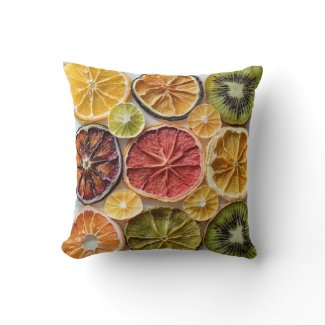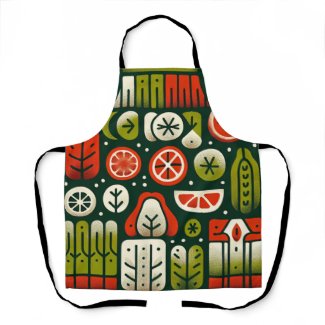- Home
- How To Dehydrate Vegetables
- How To Dehydrate (Green) Beans
How to Dehydrate Beans

Susan Gast | Author and blogger at Bored Boomers, Beesville Books, A New Sober You and Easy Food Dehydrating
Green Beans: Fresh, Frozen, or Canned
If learning how to dehydrate beans is at the top of your to-do list, this guide will walk you through the entire process. Whether you're working with fresh, frozen, or canned green beans, I'll cover everything you need to know, including drying techniques, storage methods, and recipe ideas.
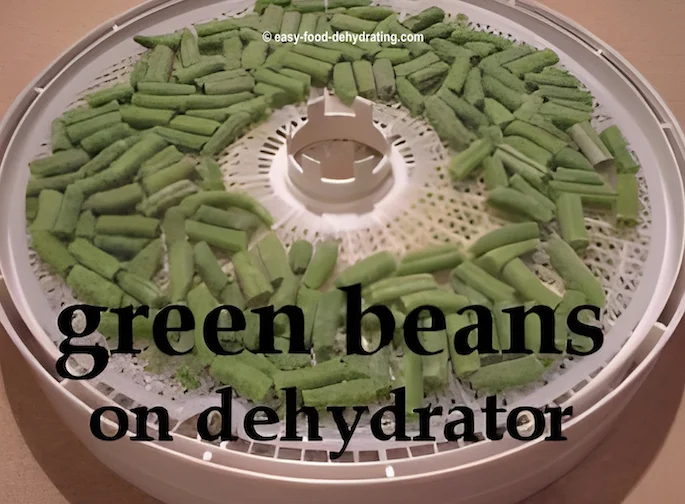
Which Type of Beans Work Best for Dehydration?
You can dehydrate fresh, frozen, or canned green beans, and each has its own benefits:
- Fresh Green Beans – Requires blanching before dehydrating.
- Frozen Green Beans – Pre-blanched, so they’re ready to dehydrate right away.
- Canned Green Beans – Soft and require no cooking, making them the easiest option for beginners.
Dehydrated Beans are Great in Soups
Dehydrated beans are a fantastic pantry staple for adding to homemade soups year-round. They provide rich flavor and texture while cutting down on cooking time. I often use frozen green beans straight from the bag for quick and easy dehydration.
💡 Pro Tip: Check out the Green Bean Casserole Recipe at the bottom of this guide!
Frequently Asked Questions
Can You Dry Canned Green Beans?
Can You Dry Canned Green Beans?
Yes! Canned green beans and frozen green beans can be dehydrated without blanching since they’ve already been pre-cooked. Just drain, spread them out on your dehydrator trays, and dry at 125°F for 6-8 hours.
How Long Do Dehydrated Green Beans Last?
How Long Do Dehydrated Green Beans Last?
When stored properly in a food vacuum-sealer bag with an oxygen absorber tucked in, dehydrated green beans can last for months or even years.
How Do You Dry Green Beans for Seeds?
How Do You Dry Green Beans for Seeds?
Follow these steps to properly dry green bean pods for saving seeds:
- Let green bean pods fully ripen on the vine until they turn brown and crispy.
- Pick the pods, then spread them out on mesh screens or newspaper in a warm, dry place with good airflow.
- Let them dry for 1-2 weeks, turning occasionally.
- Once dried, split open the pods, remove the seeds, and discard the pods.
- Spread the seeds on a screen or baking sheet and dry them for another 2-3 weeks.
- Store in an airtight container in a cool, dark place with rice grains to absorb excess moisture.
💡 Pro Tip: Thoroughly dried bean seeds should have a moisture content of 10-15% for long-term storage.
Is It Possible to Use Home-Canned Beans?
Is It Possible to Use Home-Canned Beans?
Yes, but be aware that home-canned beans tend to shatter during dehydration, especially if they are extra firm.
Why Did My Beans Shatter While Dehydrating?
Why Did My Beans Shatter While Dehydrating?
This can happen depending on the thickness of the bean’s skin and how long they were dehydrated. If they’re going into a soup, they’ll still work fine!
Can You Damage Your Teeth Eating Dried Beans?
Can You Damage Your Teeth Eating Dried Beans?
Yes! Dried beans can be very hard to chew, which may cause dental issues. If you have concerns, soak them overnight before cooking or check with your dentist before consuming dried beans.
Green Bean Nutrition Info
Dehydrated green beans are packed with essential vitamins and minerals:
Vitamins:
- High in: Vitamin A, Choline, Vitamin C
- Good amounts of: Folate, Vitamin K
Minerals:
- Major minerals: Potassium, Calcium, Phosphorus, Fluoride, Magnesium
- Trace minerals: Iron, Selenium, Zinc, Manganese, Copper
Healthy Fats:
- Contains Omega-3 and Omega-6 fatty acids
💡 Pro Tip: Add dehydrated green beans to vegetable soup or mix them into a hearty chicken & vegetable soup for an extra nutritional boost!
Top Methods for Drying Beans
1. Oven Drying
Oven drying is faster but less consistent than a dehydrator. To oven dry:
- Preheat your oven to its lowest setting (125°F if possible).
- Spread beans in a single layer on a baking sheet.
- Dehydrate for 12-24 hours, depending on bean size and type.
2. Using a Dehydrator
A dehydrator provides better temperature control and even drying.
- Set temperature: 125°F – 135°F
- Drying time: 6-8 hours
💡 Pro Tip: Rotate trays periodically to ensure even drying.
How to Dehydrate Green Beans in a Dehydrator - Fresh
If using FRESH green beans:
- Gently wash fresh beans. Trim off the ends.
- Blanch in a small amount of boiling water for about 3 to 5 minutes.
- Arrange the green beans on your dehydrator trays, making sure the beans don't overlap.
- Turn on your food dehydrator and set the temperature between 125°F and 135°F (or per your food dehydrator's instructions).
- Drying time: between 6-8 hours.
💡 Tip: Use our Fahrenheit to Celsius converter here on our site!
Blanching helps the beans retain their lovely green color PLUS it helps crack their skins which, in turn, helps the beans to dehydrate more evenly. Otherwise, you risk getting 'case-hardening.'
This occurs when the outside dries too fast, leaving the insides damp. Avoid that at all costs. You don't want to be eating bad beans!
- Green beans will feel tough and brittle when dried.
- Please remember to rotate your dehydrator trays for even drying.
If using canned beans, simply drain and rinse. Place directly on your trays; no need for a solid or non-stick sheet.
Dehydrating Frozen Green Beans

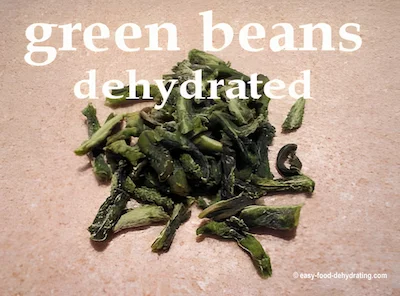
If using FROZEN green beans:
- Arrange the green beans on your dehydrator trays, making sure the beans don't overlap.
- Turn on your food dehydrator and set the temperature between 125°F and 135°F (or per your food dehydrator's instructions). Drying time: between 6-8 hours.
💡 Tip: Use our Fahrenheit to Celsius converter here on our site!
Break Up Clumps of Frozen Green Beans
If your frozen beans are clumping, let them sit in the kitchen sink, unopened, for about an hour. Or you can simply drop the unopened bag on the kitchen countertop a few times to break them apart.
Dehydrating Canned Green Beans
Don't forget you can use canned green beans in a pinch!
Just drain them and dry them on the dehydrator. Check out the canned beans info. below.
Dried Beans vs. Canned Beans: Which Is Better?
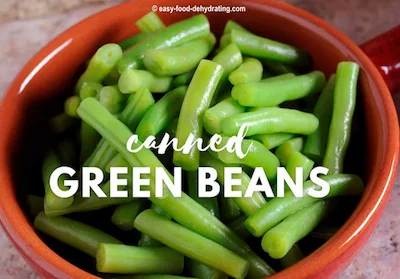
Dried beans that have been prepared at home will not rehydrate as quickly as canned beans. When drying, canned beans split open, but uncooked dry beans rehydrate better.
The most significant reason to dehydrate cooked beans rather than using raw dry beans is the cooking time. This would save time and energy in an off-grid scenario.
Beans frequently break apart when they are dried, but they still taste delicious and offer high amounts of protein and other nutrients to backpacking meals.
Dehydrated Beans: Before & After
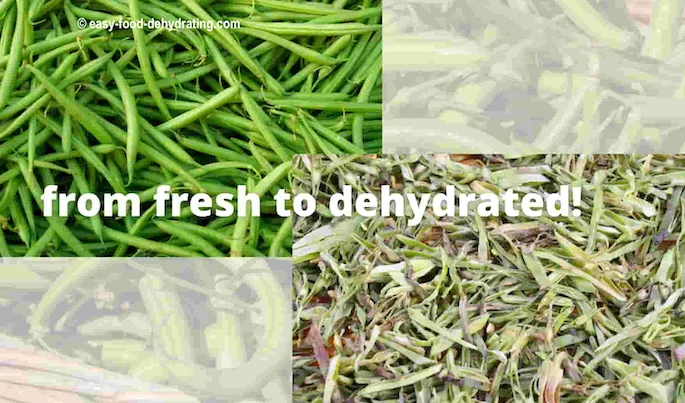
Shown above are some fresh string beans and dehydrated string beans.
When dehydrating your own fresh beans, it is important to start with clean, dry beans. Rinse the beans thoroughly and then spread them out on a clean surface to air dry. Once they are dry, you can begin the process of dehydration.
Storing Your Dehydrated Beans
If you're dehydrating beans for shorter-term storage and intend to consume them in a week or two, they may be kept on the counter or in your pantry in sealed containers or zip-top bags.
For mid-range storage (a month or two), simply allow them to cool after dehydrating (this is called conditioning) before sealing them inside an airtight container.
I like using Ziploc bags or Mason jars because they are reusable.
Mason jars are great for three reasons:
- Airtight - remember to add a 100cc oxygen absorber
- Clear glass, so you can see what's inside
- And they look great on your pantry shelves!
Shown below are green beans being vacuum sealed in vacuum sealer bags for long-term storage.
These vacuum-sealed packages will be placed inside mylar bags, and then in airtight bins, or feed-grade buckets.
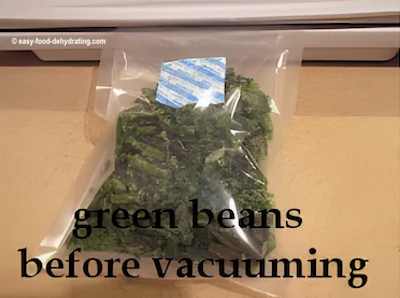
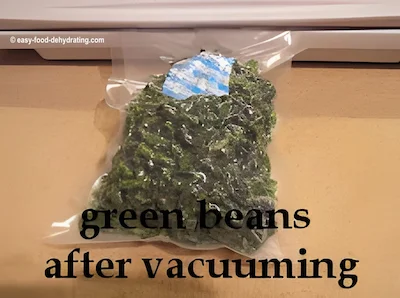
How to Vacuum-Seal & Store Dehydrated Beans
After you've dehydrated your beans, it's time to store them. Whether for long- or short-term storage, you need to use a food vacuum sealer so you can remove the air. I personally love the Foodsaver brand.
A Foodsaver food vacuum-sealing machine draws the air out of the vacuum-sealer bags. Remember to add a 100cc oxygen absorber inside the vacuum-sealer bag, before drawing the air out!
Rehydrating Green Beans: Best Methods
Rehydrate your dehydrated beans with clean cold water. Granted, beans can remain a little tough, even after dehydrating them.
Soak the beans in clean cold water for at least four hours, or overnight.
They do make delicious snacks: see Farmgal Val's contribution a little farther down.
Dehydrated Beans for Backpacking Meals
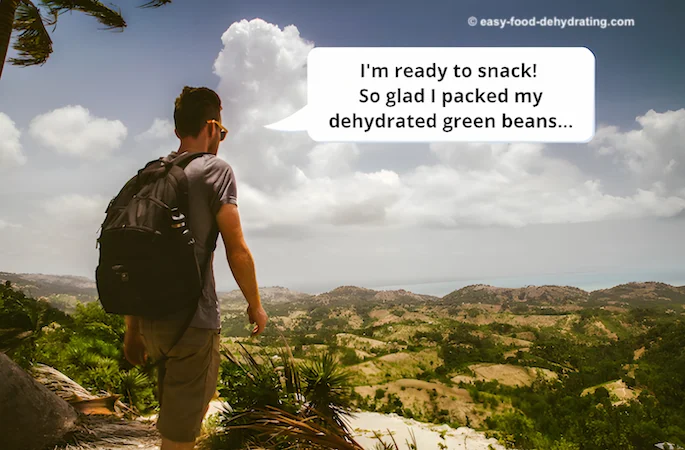
How to Dehydrate Beans for Snacks
Here's how to make a dehydrated green bean snack.
Prepare your beans by following the 'fresh beans' instructions mentioned further up the page. Lightly toss your beans in salt.
OVEN: Place the beans on cookie sheets that are lined with parchment paper and dry in a regular oven on the lowest heat possible... or use a dehydrator! This is another reason why I prefer to use a dehydrator... you know exactly what temperature to use, namely 125°F to 135°F for 6 to 8 hours.
💡 Tip: Use our Fahrenheit to Celsius converter here on our site!
DEHYDRATOR: Place your salted beans on dehydrator trays on top of solid sheets. This will keep the salt from falling down into the lower trays.
Your beans will feel nice and crispy when fully dehydrated. Don't over-dry them for snacking; and watch your teeth.
A Quick Note About Black Beans
I tried to cook black beans once. Never again. Took far too long. I even tried pressure cooking but was too concerned about 'froth' blocking up the pressure cooker valve... so I didn't try it!
Now I use canned black beans all the time and love them in this Black Bean Soup recipe.
Thanks for reading! Share this page with your buddies.
Free Resource
Don't forget to grab your free Six Simple Steps eBook! It’s packed with tips for dehydrating everything from fruits and veggies to dog treats. Get it here.
Before You Go...
If you like the content, please give me some love by clicking on the 🩷 in the lower right hand corner (on just about all my pages). This signals to me that you find it enjoyable and useful. Thank you so much!




